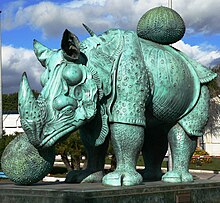丢勒的犀牛
外观
| 犀牛 | |
|---|---|
 | |
| 艺术家 | 阿尔布雷希特·丢勒 |
| 年份 | 1515年 |
| 类型 | 木板画 |
| 尺寸 | 21.4 cm × 29.8 cm(8.4英寸 × 11.7英寸) |
《丢勒的犀牛》是一幅由德国画家、版画家阿尔布雷希特·丢勒于1515年创作的木刻版画。[1]作品建基于一幅由不知名画家所画的素描印度犀牛。画中的犀牛早几年来到里斯本,是自从罗马帝国以来第一只活的样本。然而,丢勒本人从没见过那只犀牛的实体。1515年末,葡萄牙国王曼努埃尔一世把这只这头犀牛送赠给教宗利奥十世作为礼物,但犀牛于1516年初在意大利一次海难中死去。自此直至到1579年左右印度进贡一头犀牛给西班牙的腓力二世,欧洲才再次见到活体的犀牛。[2][3]
尽管画中犀牛的构造并不正确,但丢勒的版画却风靡整个欧洲,并在接下来的三个世纪被大量拷贝。在十八世纪晚期以前,这幅画依然被认为表达着犀牛的真正模样。最终,作品被后来一些更真实的素描与绘画所取代,尤其是有关犀牛克拉拉的绘图。有人曾这样说:“再没有动物图画像《丢勒的犀牛》般对于艺术影响深厚。”[4]
从没见过的动物
[编辑]1515年5月20日,一只印度犀牛从印度被运到里斯本。早在1514年初,葡属印度的总督阿尔布克尔克派遣大使到坎贝(即今天的古吉拉特邦)的统治者苏丹Muzafar二世那里去,寻求准许他可以在第乌(Diu)上兴建堡垒。任务最终以失败告吹,但双方却交换了外交礼物,当中包括了犀牛。[5]
丢勒的木刻版画
[编辑]嗯。
注解
[编辑]- ^ 有资料错误地say 1513, copying a typographical error made by Dürer in one of his original drawings and perpetuated in his woodcut. (Bedini, p.121.)
- ^ Clarke, chapter 2.
- ^ A street in Madrid was named Abada (rhinoceros in Portuguese) after this animal, that had a curious life too: [1] (页面存档备份,存于互联网档案馆). 存档副本. [2007-01-10]. (原始内容存档于2007-11-14). (in Spanish)
- ^ Quoted in Clarke, p.20.
- ^ Bedini, p.112.
参考资料
[编辑]
- Bedini, Silvano A. The Pope's Elephant. Manchester: Carcanet Press. 1997. ISBN 978-1-85754-277-6. (particularly Chapter 5, "The Ill-Fated Rhinoceros")
- Clarke, T. H. The Rhinoceros from Dürer to Stubbs: 1515–1799. London: Sotheby's Publications. 1986. ISBN 978-0-85667-322-1. (particularly Chapter 1, "The first Lisbon or 'Dürer Rhinoceros' of 1515")
- David Quammen (2000), The Boilerplate Rhino: Nature in the Eye of the Beholder, Scribner, ISBN 978-0-684-83728-4 (particularly p.201-209, The Boilerplate Rhino, previously published in this "Natural Acts" column in Outside magazine,June 1993)
外部链接
[编辑]- Albert Dürer(页面存档备份,存于互联网档案馆),T. Sturge Moore所撰,古腾堡计划
- Vector Graphic Adaptions of Dürer's Rhinoceros(页面存档备份,存于互联网档案馆) in Adobe Illustrator Format by LAFKON(页面存档备份,存于互联网档案馆)(under a creative commons license)
- The rhinoceros[永久失效链接] by Albrecht Dürer,in the collection of the National Gallery of Victoria。
